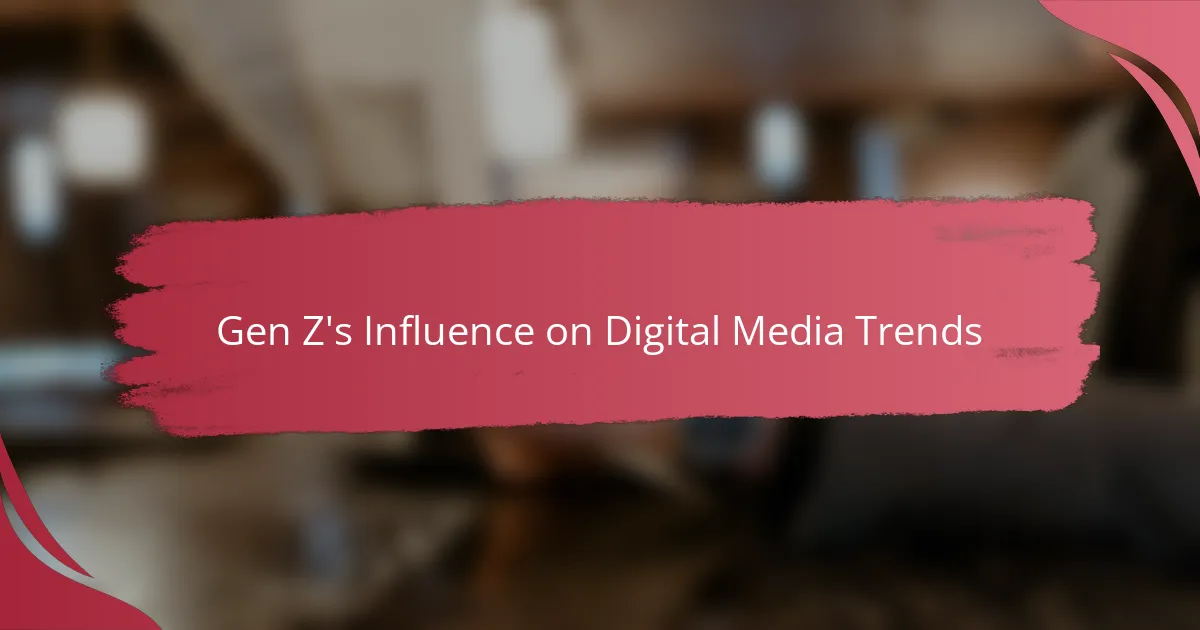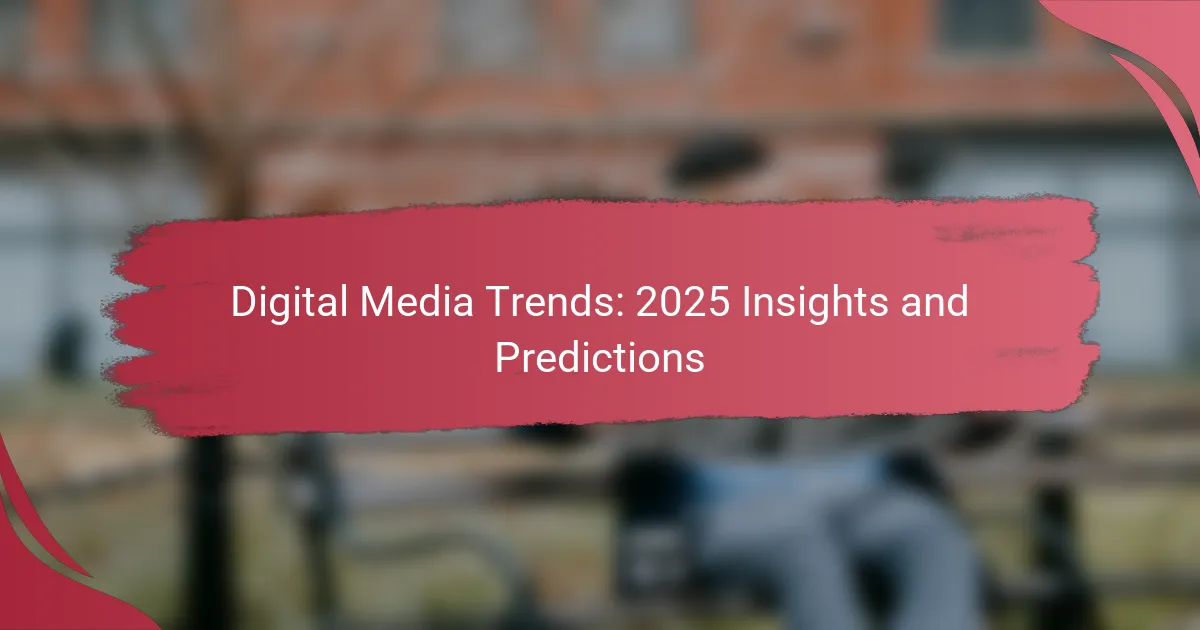Social media plays a pivotal role in shaping digital media trends by enabling real-time interactions and promoting content sharing among users. Platforms like Facebook, Instagram, and TikTok not only influence how content is created and consumed but also provide valuable insights for marketers seeking to engage their audiences effectively. As trends emerge rapidly, brands can harness these dynamics to enhance visibility and drive sales through targeted advertising campaigns.
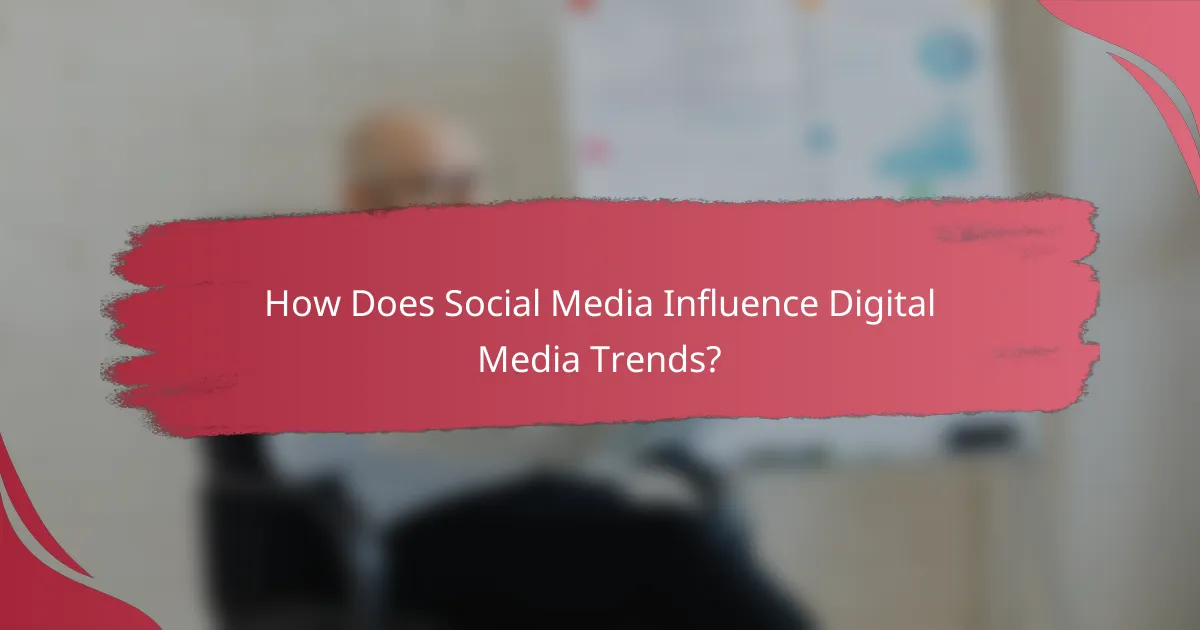
How Does Social Media Influence Digital Media Trends?
Social media significantly shapes digital media trends by facilitating real-time interactions, promoting content sharing, and providing valuable insights for marketers. Its dynamic nature allows trends to emerge rapidly, impacting how content is created and consumed across various platforms.
Real-time audience engagement
Social media enables brands to engage with their audience instantly, allowing for immediate feedback and interaction. This engagement can take the form of comments, likes, shares, and direct messages, creating a two-way communication channel that fosters community and loyalty.
Brands can leverage real-time engagement by hosting live Q&A sessions or polls, encouraging participation and gathering insights into audience preferences. This responsiveness can enhance brand reputation and drive user-generated content, further amplifying reach.
Content virality and sharing
Content on social media can go viral quickly, reaching vast audiences in a short time. Factors contributing to virality include emotional resonance, relatability, and shareability, which encourage users to disseminate content within their networks.
To increase the chances of virality, brands should create compelling, visually appealing content that resonates with their target audience. Utilizing trending topics and hashtags can also enhance visibility and encourage sharing, potentially leading to exponential growth in reach.
Data-driven insights for marketers
Social media platforms provide marketers with rich data analytics that reveal user behavior, preferences, and engagement patterns. This data can inform content strategies, helping brands tailor their messaging to better resonate with their audience.
Marketers should regularly analyze metrics such as engagement rates, click-through rates, and demographic information to refine their campaigns. A/B testing different content formats and posting times can also yield insights into what works best for their specific audience.
Influencer partnerships
Influencer partnerships are a powerful way to leverage social media’s reach and credibility. By collaborating with influencers who align with their brand values, companies can tap into established audiences and enhance their visibility.
When selecting influencers, brands should consider factors such as audience demographics, engagement rates, and authenticity. Establishing clear expectations and measurable goals for the partnership can help ensure mutual benefits and effective campaigns.
Platform algorithms shaping content
Social media algorithms play a critical role in determining which content is shown to users, influencing what trends gain traction. These algorithms prioritize content based on user interactions, relevance, and timeliness, making it essential for brands to understand how they work.
To optimize content for algorithms, brands should focus on creating high-quality, engaging posts that encourage interactions. Regularly updating strategies based on algorithm changes can help maintain visibility and relevance in a crowded digital landscape.
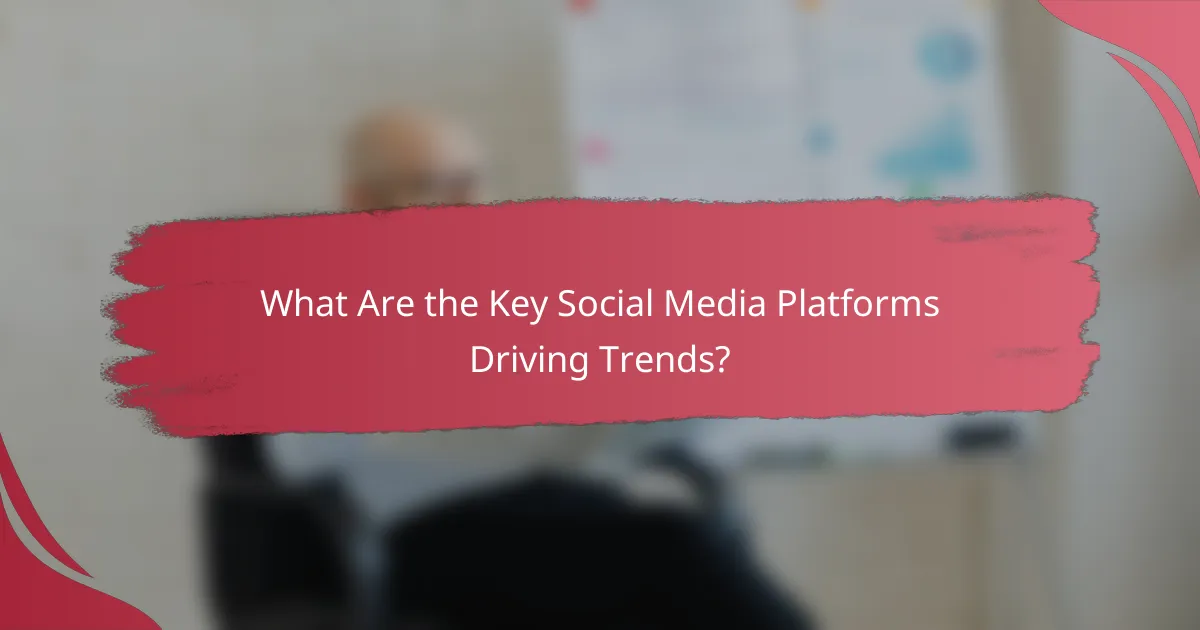
What Are the Key Social Media Platforms Driving Trends?
Key social media platforms like Facebook, Instagram, TikTok, Twitter, and LinkedIn significantly influence digital media trends by shaping user engagement and content consumption. Each platform has unique features that cater to different audiences, driving specific trends in advertising, storytelling, and networking.
Facebook’s advertising ecosystem
Facebook’s advertising ecosystem is robust, allowing businesses to target specific demographics effectively. With options for detailed audience segmentation, advertisers can reach users based on interests, behaviors, and location, making it a powerful tool for driving conversions.
Brands often utilize Facebook Ads to promote products or services, leveraging formats like carousel ads and video ads to engage users. A well-structured campaign can yield a return on ad spend (ROAS) that varies widely, often ranging from 200% to 400% depending on the industry and targeting precision.
Instagram’s visual storytelling
Instagram excels in visual storytelling, making it ideal for brands looking to showcase products through high-quality images and videos. The platform’s emphasis on aesthetics encourages creative content that resonates with users, driving engagement and brand loyalty.
Features like Stories, Reels, and IGTV allow brands to share diverse content formats, enhancing their storytelling capabilities. Brands should consider using a mix of these features to maintain user interest and capitalize on trends like influencer partnerships, which can significantly boost visibility.
TikTok’s short-form video impact
TikTok has revolutionized content consumption with its short-form video format, appealing to younger audiences and driving viral trends. The platform’s algorithm promotes engaging content, allowing even new creators to gain visibility quickly.
Brands can leverage TikTok by creating authentic, entertaining videos that align with trending challenges or sounds. Successful campaigns often focus on creativity and relatability, with many brands seeing significant increases in brand awareness and engagement when they participate in popular trends.
Twitter’s real-time news dissemination
Twitter serves as a real-time news dissemination platform, making it essential for brands to stay relevant in fast-paced conversations. The platform’s character limit encourages concise messaging, which is crucial for capturing attention quickly.
Brands can use Twitter to engage in trending topics or respond to current events, enhancing their visibility and relevance. However, it’s important to maintain a consistent brand voice and avoid missteps that could lead to backlash in the public eye.
LinkedIn’s professional networking
LinkedIn is the leading platform for professional networking, making it vital for B2B marketing and recruitment. The platform allows users to connect with industry professionals, share insights, and showcase expertise through articles and posts.
Companies can enhance their presence on LinkedIn by sharing valuable content, participating in discussions, and utilizing LinkedIn Ads to target specific industries. Engaging with the professional community can lead to increased brand credibility and opportunities for collaboration or partnerships.

How Can Brands Leverage Social Media for Advertising?
Brands can effectively leverage social media for advertising by creating targeted campaigns that resonate with their audience. By utilizing various strategies, they can enhance engagement, increase brand visibility, and ultimately drive sales.
Targeted ad campaigns
Targeted ad campaigns allow brands to reach specific demographics based on interests, behaviors, and location. Platforms like Facebook and Instagram offer robust tools for defining audiences, enabling brands to tailor their messaging for maximum impact.
Consider using A/B testing to refine your ads. This involves running two variations of an ad to see which performs better, helping optimize your advertising spend and improve conversion rates.
Engaging content strategies
Creating engaging content is crucial for capturing audience attention on social media. Brands should focus on storytelling, visuals, and interactive elements to foster a connection with their audience.
Utilize formats like videos, polls, and live streams to enhance engagement. Content that encourages participation, such as quizzes or challenges, can significantly boost visibility and shares.
Utilizing user-generated content
User-generated content (UGC) is a powerful tool for brands, as it builds trust and authenticity. Encouraging customers to share their experiences with your products can create a sense of community and enhance brand loyalty.
Brands can incentivize UGC through contests or features on their official pages. This not only provides fresh content but also showcases real-life applications of products, making them more relatable to potential customers.
Measuring ROI through analytics
Measuring return on investment (ROI) is essential for understanding the effectiveness of social media advertising. Brands should utilize analytics tools provided by platforms to track engagement, conversions, and overall performance.
Focus on key metrics such as click-through rates, conversion rates, and customer acquisition costs. Regularly reviewing these metrics can help refine strategies and ensure that advertising efforts align with business goals.
Building brand loyalty through interaction
Interaction with followers is vital for building brand loyalty on social media. Responding to comments, messages, and reviews fosters a sense of community and shows that the brand values customer feedback.
Consider implementing regular Q&A sessions or live chats to engage directly with your audience. This not only enhances customer relationships but also provides valuable insights into their preferences and needs.
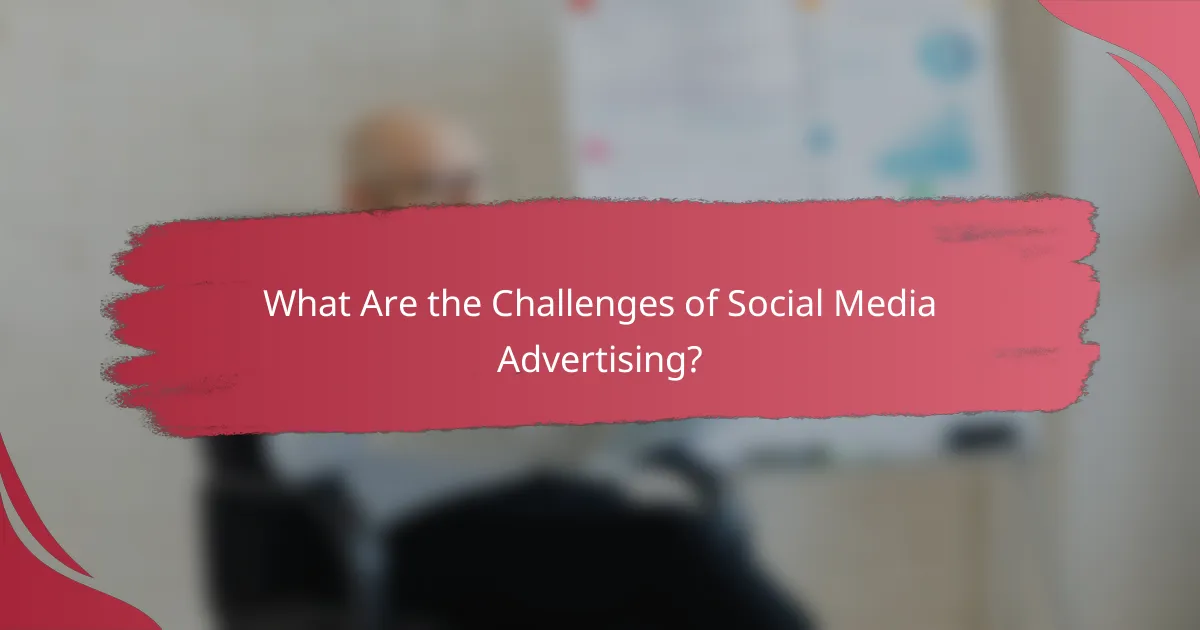
What Are the Challenges of Social Media Advertising?
Social media advertising faces several challenges that can hinder its effectiveness, including user ad fatigue, algorithm changes, negative feedback management, regulatory compliance, and content saturation. Understanding these issues is crucial for optimizing ad strategies and achieving better engagement.
Ad fatigue among users
Ad fatigue occurs when users become desensitized to repeated advertisements, leading to decreased engagement and effectiveness. This can happen quickly, especially if the same ads are shown too frequently or lack variety. To combat ad fatigue, consider rotating your ad creatives regularly and targeting different audience segments.
Utilizing A/B testing can help identify which ads resonate best with your audience, allowing you to refresh content proactively. Aim for a balance between frequency and novelty to maintain user interest.
Algorithm changes affecting visibility
Social media platforms frequently update their algorithms, which can significantly impact the visibility of ads. These changes may prioritize certain types of content or user interactions, making it essential for advertisers to stay informed about platform updates. Regularly reviewing performance metrics can help you adapt your strategies accordingly.
Engaging with your audience through comments and shares can improve organic reach, making it more likely that your ads will be seen. Diversifying your ad formats, such as using video or stories, can also help maintain visibility amidst algorithm shifts.
Managing negative feedback
Negative feedback on social media can damage brand reputation and deter potential customers. It is vital to monitor comments and reviews actively, responding promptly and professionally to any criticism. Addressing concerns transparently can turn negative experiences into positive ones.
Establishing a clear protocol for handling negative feedback can streamline your response process. Encourage satisfied customers to leave positive reviews, which can help balance out any negative comments.
Compliance with advertising regulations
Compliance with advertising regulations is crucial to avoid legal issues and maintain consumer trust. Different countries have varying rules regarding advertising practices, including truth in advertising, data privacy, and targeted advertising restrictions. Familiarize yourself with local laws to ensure your campaigns are compliant.
Consider consulting legal experts or using compliance tools to help navigate these regulations. Staying informed about changes in advertising laws can prevent costly mistakes and enhance your brand’s credibility.
Content saturation in competitive markets
In highly competitive markets, content saturation can make it difficult for ads to stand out. With numerous brands vying for attention, creating unique, high-quality content is essential. Focus on delivering value through informative or entertaining ads that resonate with your target audience.
Utilizing niche targeting can help reach specific segments of your audience, reducing competition and increasing relevance. Collaborating with influencers or leveraging user-generated content can also provide fresh perspectives that capture attention in a crowded space.

